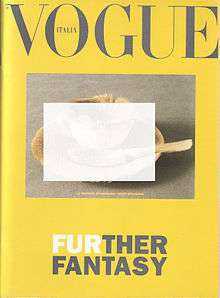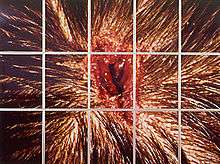Mat Collishaw
| Mat Collishaw | |
|---|---|
 Further Fantasy - Exhibition Galleria Giò Marconi, Milano, 1.-21. March 1999, catalogue Associazione Italiana Pellicceria by Vogue Italia. | |
| Born |
1966 (age 49–50) Nottingham, England |
| Nationality | English |
| Known for | Installation, Sculpture, Photography |
| Movement | Contemporary Art, Young British Artists |
Matthew "Mat" Collishaw (born 1966 in Nottingham) is an English artist based in London.
Career

His work uses photography and video. His best known work is Bullet Hole (1988), which is a closeup photo of what appears to be a bullet hole wound in the scalp of a person's head, mounted on 15 light boxes. Collishaw took the original image from a pathology textbook that actually showed a wound caused by an ice pick.[1] Bullet Hole was originally exhibited in Freeze, the group show organised by Damien Hirst in 1988 that launched the YBA (Young British Artists). It is now in the collection of the Museum of Old and New Art in Hobart, Australia.[2]
Collishaw is represented by BlainSouthern in London and Berlin, Tanya Bonakdar Gallery in New York City,[3] Raucci/Santamaria Gallery in Naples and Galerie Analix Forever in Geneva.
Working practice
The Victoria & Albert Museum commissioned Collishaw with a monumental onsite project, Magic Lantern, which – installed in the cupola above the entrance – appropriated the architecture of the V&A creating a beacon of light, complete with an attendant swarm of moths, and was visible across London during the winter months of 2010 - 2011. This is not an exit, 2013 at Blain|Southern Gallery, London, saw Collishaw return to medium of oil painting. However, as is usual with his practice, nothing is literal; the primary source material – magnified images drawn from the pages of glossy magazines - is a simple metaphor, one part of a prism conceived to examine moral questions provoked by the excessive binge culture that preceded the global financial crisis. When seen from a distance, these large-scale works appear to be abstract paintings constructed on a classic modernist grid; closer inspection reveals them to be scraps of advertisements for luxury goods culled from ‘lifestyle’ magazines like Tatler and Vogue. But this is only partially the case; they are in fact facsimiles of the precisely folded, origami-like ‘wraps’ used by drug dealers to package cocaine, complete with powdery traces of the narcotic. In 2014 Collishaw held a solo exhibition at Galleria Borghese, Rome, titled Black Mirror whereby he responded to the works in the Borghese collection. Three paintings by Caravaggio (Madonna and Child with St. Anne - Dei Palafrenieri, David with the Head of Goliath, Saint Jerome Writing) appear and disappear behind the surfaces of large mirrors framed in black Murano glass. The figures are animated to appear as though posing for the painting; breathing, blinking and shifting their weight in front of us. Everyday people caught in the process of being transformed into religious icons, trapped like spectres in an indeterminate space between the real world and the realm of the painting. The Massacre of the Innocents by Ippolito Scarsella was referenced by a fourth work on the ground floor of the museum. Featuring over 300 characters, the Biblical tale of genocide is re-enacted in All things Fall, as a cornucopia of savagery comes to life in a heaving mass of kaleidoscopic brutality - forever trapped in a frenzied purgatory of interminable violence. Collishaw held a major retrospective at New Art Gallery Walsall, in 2015. The exhibition included photography, film, sculpture and installation and testified to the richness and breadth of Collishaw’s practice, highlighting and exploring some of the overriding themes and preoccupations within his work. Works from 1996 through to 2015 were presented over two floors, including his ambitious installation, Deliverance (2008), repeated projections onto walls coated in phosphorescent paint present ghostly figures that appear suddenly and then slowly fade, only to be replaced by another. Drawing on the news coverage of the 2004 Beslan siege, Collishaw makes reference to the seemingly insatiable appetite of the press for images of disaster and trauma and of the complex and often ambivalent ways in which we as viewers respond to these distressing scenes. The exhibition included works from the photographic series’ Single Nights (2007), Insecticides(2006-ongoing) and Catching Fairies (1996) as well as the sculptural series The Venal Muse (2012-15) in which brightly coloured flowers, presented in vitrines, reveal on close inspection evidence of disease and decay. New Art Gallery Walsall also staged the UK premier of Collishaw’s acclaimed zoetrope, All Things Fall.Concurrent to the exhibition at Walsall, Collishaw presented In Camera, a work commissioned by GRAIN and The Library of Birmingham, inspired by the Library’s internationally renowned photography collection. In 2016, Collishaw created two striking new installations for the follies in the 18th century landscape surrounding Fountains Abbey and Studley Royal - a National Trust World Heritage Site in Yorkshire, UK. A co-commission between the Trust and Blain|Southern, the works drew upon the history of the buildings and are optical illusions that echo ghosts of the past. The Banqueting House became the site for a major new 3D zoetrope titled Seria Ludo. The work is a glowing, strobe lit chandelier, covered with 186 carousing Lilliputian figures. As it spins, the zoetrope animates the tableaux, bringing scenes of drunken revelry to life as characters - including a swinging monkey - eat, drink, fight and dance. In contrast, the Temple of Piety – serenely stationed at the edge of the garden’s Moon Ponds, is the setting for a work that is more tranquil, The Pineal Eye sees two parabolic mirrors face each other. The resulting optical effect creates an ethereal mirage of the Roman depiction of piety, the Grecian daughter feeding her imprisoned father from her breast, which also appears as a relief on the back wall of the Temple. In addition to the pictorial beauty offered by the water gardens, they also function as hydraulic balancing systems for the river Skell that flows through Fountains Abbey. Illustrating this form of release was one of Collishaw's main objectives when creating Seria Ludo and The Pineal Eye, two works which illustrate an explosion of tension, with themes that plumb into the follies' principles of pleasure and piety.
Influences
British pathologist, Austin Gresham, wrote a handbook, A Colour Atlas of Forensic Pathology, in 1975. Collishaw said it became "the Britart bible", as a source for explicit images of dead bodies for artwork.[4][5]
Personal life
Collishaw was raised in a Dawn Christadelphian family.[6]
In 2015, he was named one of GQ's 50 best dressed British men.[7]
Exhibitions
Selected recent solo exhibitions
- 2013 'La vie de château', Château des Adhémar - Centre d'Art Contemporain, Montélimar, FR.
- 2013 'This is Not an Exit', Blain|southern, London, UK.
- 2012 'Crystal Gaze', Raucci/Santamaria Gallery, Naples, IT.
- 2012 'The End of Innocence', Dilston Grove, CGP London Gallery, London, UK.
- 2012 'Sordid Earth', Greenaway Art Gallery, Kent Town, AU.
- 2012 'Vitacide', Tanya Bonakdar Gallery, New York City.
- 2011 'Pearls of the Abyss', Analix Forever, Geneva, CH
- 2010 'Last Meal on Death Row', Analix Forever, Geneva, CH.
- 2010 'Magic Lantern', Victoria & Albert Museum, London, UK.
- 2010 'Shooting Stars & The Garden of Unearthly Delights', Void Gallery, Derry, IE.
- 2010 'Creation Condemned', Blain|Southern, London, UK.
- 2010 'Retrospectre', British Film Institute, London, UK.
- 2009 'Submission', Haunch of Venison, Berlin, DE.
- 2009 'Hysteria', Freud Museum, London, UK.
- 2008 'Mat Collishaw: Shooting Stars', Haunch of Venison, London, UK.
- 2008 'Mat Collishaw Deliverance', Tanya Bonakdar Gallery, New York City.
Selected recent group exhibitions
- 2012 'White Light/White Heat: Contemporary Artists & Glass', Wallace Collection, London UK.
- 2012 'Britain Creates 2012: Fashion + Art Collusion', Victoria & Albert Museum, London, UK.
- 2012 'Des Images, Des Histoires', Palais Jacques Coeur, Paris, FR.
- 2012 'Out of Focus: Photography', Saatchi Gallery, London, UK.
- 2011 'Memories of the Future, The Olbricht Collection', La Maison Rouge, Paris, FR.
- 2011 'Sordid Earth', Roundhouse, London, UK.
- 2011 'Otherworldly: Optical Delusions and Small Realities', Museum of Arts and Design, New York City.
- 2011 'House of Beasts', Attingham Park, National Trust, UK.
- 2010 'Locus Solus', Benaki Museum, Athens, GR.
- 2010 'Extraordinary measures', Belsay Castle, Northumbria, UK.
- 2010 'Mat Collishaw, Tracey Emin & Paula Rego', Founding Museum, London, UK.
- 2009 'Distortion', Gervasuti Foundation, Venice Biennale, Venice, IT.
- 2009 'Mythologies', Haunch of Venison, Zurich, CH.
- 2007 'Les Fleurs du Mal', Arcos Sannio Contemporary Art Museum, Benevento, IT.
- 2007 'Mat Collishaw, Anthony Goicolea', Haunch of Venison, Zurich, CH.
- 2007 'The Tempest - Mat Collishaw and Paul Fryer', Gervasuti Foundation, Venice Biennale, Venice, IT.
Selected bibliography
- 'Mat Collishaw: Afterimage', by Başak Doğa Temür, Arter, Istanbul, 2013.
- 'Mat Collishaw', by Sue Hubbard, Rachel Campbell-Johnson, Blain|Southern, London, 2013.
- 'Mat Collishaw: Ou l'horreur délicieuse', by Paul Ardenne, Régis Durand, Julie Gil, Federica Martini, Barbara Polla, Michele Robecchi, Le Bord de l'eau, Brussels, 2013
- 'Mat Collishaw: Insecticides', by Nina Miall, Haunch of Venison, London, 2012.
- 'Mat Collishaw', by Neal Brown, Jason Beard, Other Criteria, London, 2007.
- 'Mat Collishaw', by Thomas Dane, Jon Thompson, Artimo Foundation Breda, 1997.
References
- ↑ "Mat Collishaw - Contemporary Artists". Bullet Hole. Saatchi Gallery. Retrieved 24 April 2009.
- ↑ Gabriella Coslovich (15 January 2011). "A revolt in art". The Age.
- ↑ Mat Collishaw at Tanya Bonakdar Gallery
- ↑ Goslett, Miles. "Meet the grandfather of Britart", The Daily Telegraph, 1 July 2007. Retrieved on 12 September 2009.
- ↑ For more on the author of this book see: " Obituary: Professor Austin Gresham histopathologist," The Times, 8 September 2009.
- ↑ The Times 2 April 2008 Mat Collishaw: a shock-jock's deliverance by Rachel Campbell-Johnston
- ↑ "50 Best Dressed Men in Britain 2015". GQ. 5 Jan 2015.
External links
- Official website
- Mat Collishaw at Blain|Southern
- Mat Collishaw at Analix Forever
- Mat Collishaw at Raucci/Santamaria
- Mat Collishaw - Tanya Bonakdar Gallery
- Mat Collishaw – Mat Collishaw at Cosmic Gallerie
- Mat Collishaw at Saatchi Gallery
- Mat Collishaw at Artfacts.Net
- Film about 2010 joint exhibition with Tracey Emin and Paula Rego at the Foundling Museum - The Guardian
- Interview of Collishaw (September 2012) at [REVma -/+]